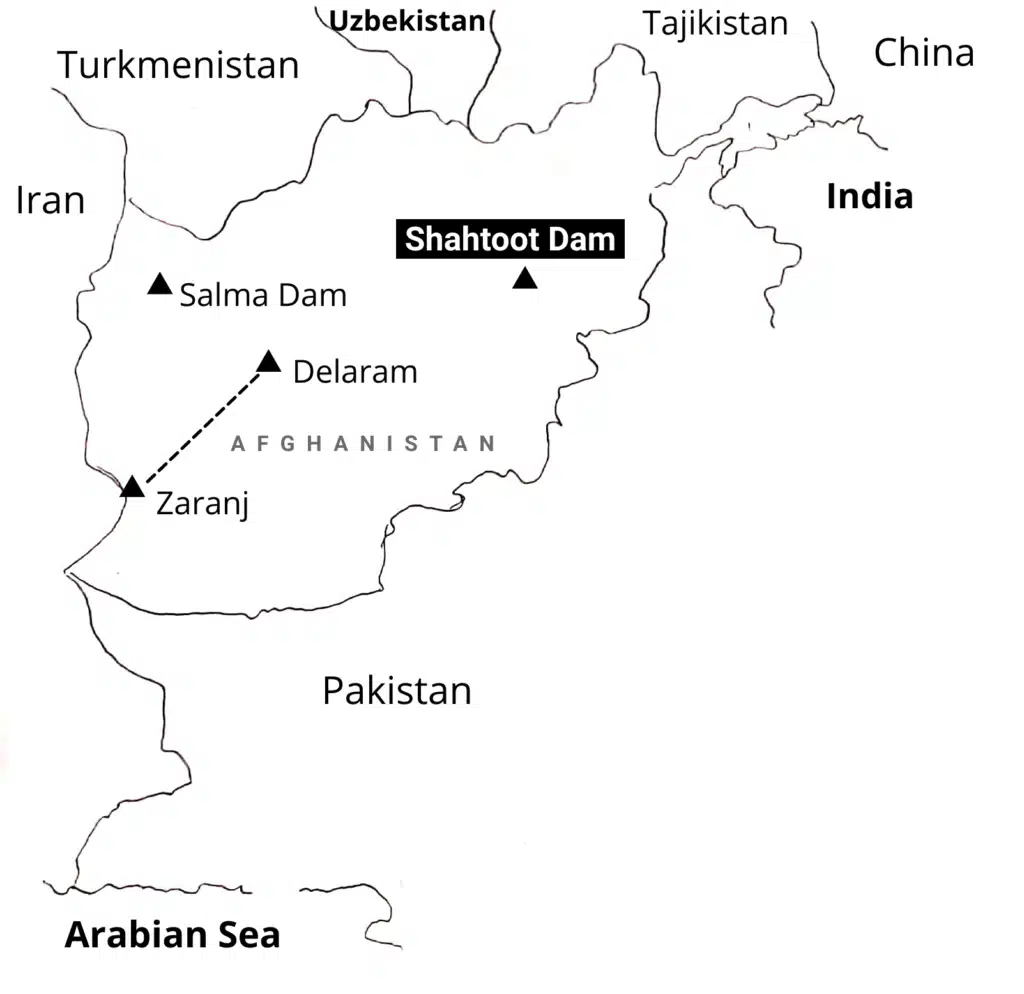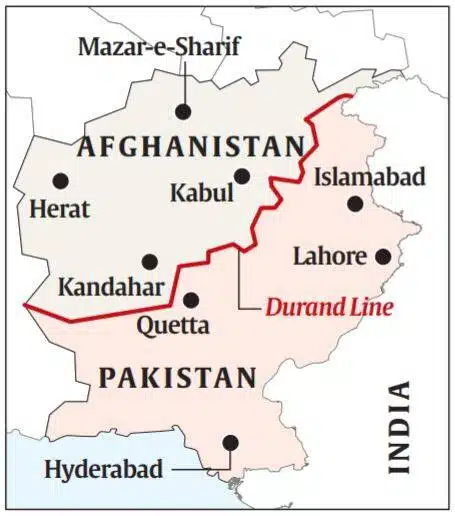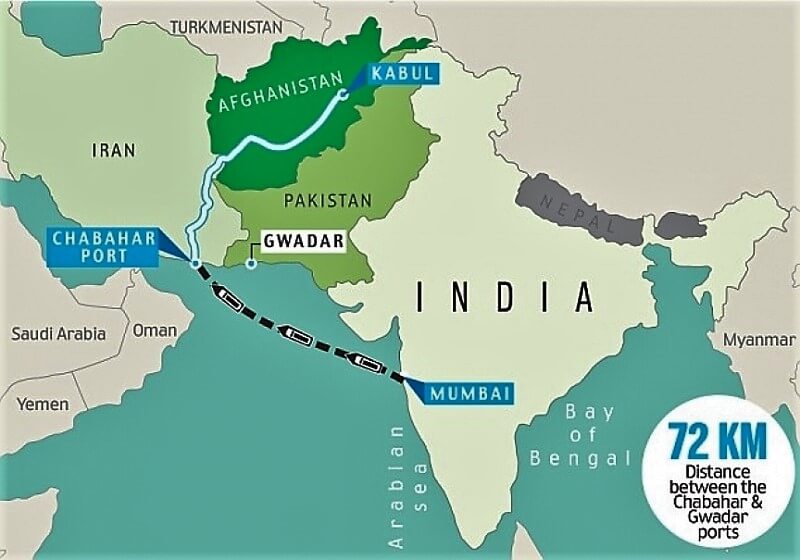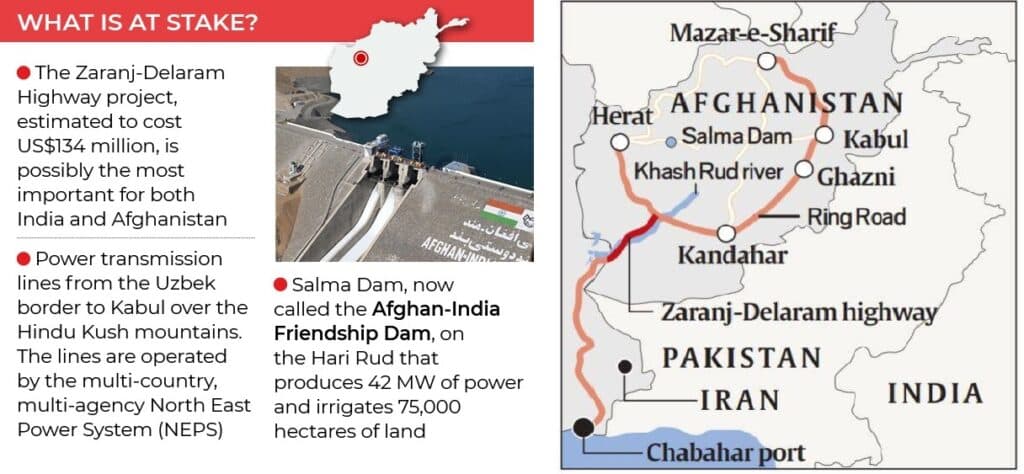India-Afghanistan Relations can be traced back to as old as Indus Valley Civilization. India and Afghanistan have a strong relationship based on historical and cultural links. After Independence, India- Afghanistan relations started formulating in January 1950 when a five-year Treaty of Friendship was signed by the then Prime Minister of India Pt. Jawaharlal Nehru and Afghan’s then Ambassador to India Mohammad Najibullah.
The relationship is not limited to the governments in New Delhi and Kabul, and has its foundations in the historical contacts and exchanges between the people. India was the only South Asian nation to recognise the Soviet-backed Democratic Republic of Afghanistan during the Soviet-Afghan war (1979-89). India also provided humanitarian aid to the then Afghan President Najibullah ‘s government. Following the withdrawal of the Soviet forces, India continued to provide Najibullah’s government with humanitarian aid. In 1999, India became one of the key supporters of the anti-Taliban Northern Alliance. India proposed Afghanistan membership to SAARC in 2005.

Historical Background
Ancient Phase
- The Indus Valley Civilization is where the ties between the people of Afghanistan and India first began and thus the foundation of the India-Afghanistan Relations was established.
- After Alexander’s Invasion, Afghanistan was ruled by the successor state of the Seleucid Empire.
- Prior to the entrance of Islam in the 7th century, much of Afghanistan was influenced by Buddhist, Hindu, and Zoroastrian civilizations which were brought from India by the Mauryans, who also dominated the region south of the Hindu Kush.
- The Muslims and Hindus coexisted in Afghanistan, despite the fact that many Afghans converted to Islam.
Colonial Phase
- Two Anglo-Afghan Wars were fought between British India and Afghanistan during the period of 1839–1842, and 1870–1880.
- Between Afghan and British lands, a boundary line is known as the Durand Line was created. However, the Durand Agreement (1893) failed to maintain peace, and soon there were tribal uprisings that lasted until 1898.
- Viceroy Curzon adopted a strategy of seclusion and focus. Tribal forces trained and led by British officers took the place of British troops who retreated from advanced sites.
- The Indian National Congress was actively supported by Khan Abdul Ghaffar Khan of Afghanistan, a significant figure in the Indian independence movement. The participation of Afghan leaders in the freedom movement is also a pillar to strengthen India-Afghanistan Relations.

Post-Independence Phase
- The Treaty of Friendship between India and India was signed in 1949, to establish diplomatic ties and deepen India-Afghanistan Relations.
- India and Afghanistan became closer diplomatically during the 1950s and 1960s.
- India was one of the first non-Communist nations to accept the Soviet Union’s administration after its 1979 invasion of Afghanistan.
- Until the establishment of the Taliban in the 1990s, India supported successive regimes of Afghanistan.
- India, however, does not acknowledge the Taliban’s rise to power in 1996, as do the majority of other nations.
- India and Afghanistan relations improved after the 9/11 attacks and the ensuing U.S.-led war in Afghanistan.
Areas of Cooperation
Political
- In 2001, India offered information and logistical support to the Allied forces during Operation Enduring Freedom. India developed diplomatic ties with the newly formed civilian government after the Taliban were overthrown, and it also took part in relief and rehabilitation activities.
- In 2005, India advocated for Afghanistan’s membership in the South Asian Association for Regional Cooperation (SAARC).
- During Hamid Karzai’s visit to India in April 2006, three memorandums of understanding(MoUs) were signed between the Bureau of Indian Standards (BIS) and the Afghan National Standardisation Authority in the fields of rural development, education, and standardisation.
- Indo-Afghan relations have been strengthened by the Strategic Partnership Agreement signed between the two countries in 2011. As Afghanistan was undergoing three simultaneous political, security and economic transitions in 2016, India had allayed its fears about its future by making a long-term commitment to the security and development of Afghanistan.
- Strategic Partnership Agreement (SPA) between the two sides, inter alia, provides for assistance to help rebuild Afghanistan’s infrastructure and institutions, education and technical assistance to re-build indigenous Afghan capacity in different areas, encouraging investment in Afghanistan’s natural resources, providing duty free access to the Indian market for Afghanistan’s exports, support for an Afghan-led, Afghan-owned, broad-based and inclusive process of peace and reconciliation, and advocating the need for a sustained and long-term commitment to Afghanistan by the international community.
- Extradition Treaty, the Agreement on cooperation in civil and commercial matters and the Memorandum of Understanding on Cooperation in Peaceful Uses of Outer Space were signed during the visit of President Ashraf Ghani in September 2016.
- In December 2016, Prime Minister of India along with a high level delegation paid a visit to Afghanistan. During his visit, he inaugurated the newly built Afghan Parliament; announced 500 scholarships for the children of the martyrs of Afghan Security Forces in school and colleges both in Afghanistan and in India; and gifted four Mi-25 Attack helicopter to Afghan Air forces. During the visit , it was decided to conduct the first Strategic Partnership Council meeting headed by the Foreign Minister of both the countries along with four joint working group meetings.
- The President of the Afghanistan, Dr. Mohammad Ashraf Ghani paid a visit to India on September 19, 2018. The leaders expressed satisfaction at the increase in bilateral trade that has crossed the US $ 1 billion mark. They also appreciated the successful conclusion of the India-Afghanistan trade and investment show in Mumbai from September 12-15, 2018.
- In August 2019, In a message, Prime Minister Modi wished Afghanistan a happy 100th anniversary of its independence.
Trade and Commerce
- The bilateral trade at USD 834.50 million for 2015-16 (US $ 526.60 million exports from India and US $ 307.90 million imports by India). This is a modest figure and has immense potential to be expanded further.
- India is the major export destination of Afghanistan. One of the objectives of building Zaranj-Delaram road by India was to boost bilateral economic relations besides offering Afghanistan another outlet to sea port. The successful operation of the Chabahar port in Iran could capitalize on this road to offer a new transit route of Afghan products to India, while opening a new route for India, and the rest of the world, for trade with Central Asia.
- India and Afghanistan signed a Preferential Trade Agreement in March 2003 under which India allowed substantial duty concessions, ranging from 50% to 100%, to certain category (38 items) of Afghan dry fruits. Afghanistan in turn has allowed reciprocal concessions to Indian products, including tea, sugar, cement and pharmaceuticals.
- India has also signed the TAPI pipeline project that aims to bring natural gas from Turkmenistan through Afghanistan and Pakistan to India.
- During the visit of President Ghani to India in September 2016, to further deepen the commercial engagement, Prime Minister proposed to supply world class and easily affordable medicines from India and cooperation in solar energy through mutually agreed instruments. Recently, a second air corridor between India and Afghanistan was inaugurated.

Cultural Relations
- India and Afghanistan share centuries old cultural heritage with deep rooted linkages in the field of music, arts, architecture, language and cuisine. In the field of music, in particular, in the old days, most Afghan musicians were trained in the Patiala Gharana.
- Today, Indian films, songs and TV serials are hugely popular with the masses, contributing significantly to the popularization of Hindi and familiarization of the populace with Indian socio-cultural value system.
- As part of India’s restructuring programme for Afghanistan, India has aimed to take up projects that will render Afghanistan’s cultural heritage sustainable. The Indian cultural centre has also been working towards building our shared cultural heritage.
- Prime Minister Narendra Modi was conferred with Afghanistan’s highest civilian honor, the Amir Amanullah Khan Award. India gave the extension of ICCR (Indian Council of Cultural Relation) scholarship till 2020.
Indian Diaspora
- Nearly 1710 Indians are estimated to be present in Afghanistan (August 2020).
- Most of the Indians are engaged as professionals in Banks, IT firms, construction companies, hospitals, NGOs, telecom companies, security companies, universities, Govt. of India sponsored projects, Govt. of Afghanistan and UN Missions.
Sports Cooperation
- India and Afghanistan have robust relations in the field of sports.
- Since 2011, Afghanistan Under-14 & Under-17 Boys’ and Under-17 Girls’ football teams have been participating in the Subroto Cup International Tournament organised every year by the India Air Force.
- Cricket has been a major factor in promoting people-to-people ties between the two countries. Afghanistan Cricket Board (ACB) has been alloted three cricket home grounds in India (Noida, Dehradun and Lucknow).
- India is also involved in construction cricket stadiums and grounds in various provinces of Afghanistan.
Developmental Aid
India’s engagement in Afghanistan has been in the fields of infrastructure development, socio-economic growth, and capacity building. Indian companies are engaged in the infrastructural development of Afghanistan and are contributing to the development of the country.
Some of the major projects successfully undertaken by India include:
- Construction of Indo-Afghan Friendship Dam (Salma Dam) and Parliament building.
- Construction of 220 kV DC transmission line from Pul-e-Khumri to Kabul, and a 220/110/20 kV substation at Chimtala.
- Construction of 218 kilometer Zaranj-Delaram corridor which is expected to connect Afghanistan and the Indian Ocean through the Chabahar port of Iran.
- A Public-Private coalition of Indian iron ore mining and steel companies (AFISCO), led by the Steel Authority of India, won the tender for the Hajigak iron ore reserves to build a 1.2 MTPA steel plant, including a 90 MW capacity power plant.
- During the 15th SAARC summit, India committed to pledging another $450 million alongside a further $750 million already pledged for ongoing and upcoming projects in Afghanistan.
- India also gave US$ 1 Million assistance for flood relief programme in Badakhshan in May 2014.
- India established Agriculture University ANASTU in Kandahar in 2014
- India also offered Afghanistan affordable pharmaceutical products and medicines. MoU signed for developing Afghan Textiles industry since Afghanistan is endowed with rich quality of cotton, silk and cashmere wool and has significant potential for development of the textile industry, which in turn may generate considerable employment opportunities.
- India gave assistance for the annual maintenance of M/s Habibiyar School, Kabul and Indira Gandhi Institute of Child Health.

Recent Developments
- India sent its first shipment of 15,000 tons of wheat to Afghanistan through Chabahar; the shipment arrived in Zaranj on November 11, 2017.
- India-Afghanistan Air Freight Corridor became operational in June 2017, shipping agricultural produce, pharmaceuticals, medical equipment to overcome the obstacle of land contiguity posed by Pakistan.
- India has agreed to extend further assistance to the Afghan National Defence and Security Forces in fighting the scourge of terrorism, organized crime, trafficking of narcotics and money laundering.
- India has agreed to develop the Shahtoot dam and other drinking water projects for Kabul, construct low-cost housing for the returning Afghan refugees in the Nangarhar province and improve road connectivity to Band-e Amir in Bamiyan to promote tourism.
- 69% of Afghan people chose India as Afghanistan’s Best Friend – According to a recent survey, Sixty-nine percent of Afghani citizens choose India as Afghanistan’s ‘best friend’
- The Taliban regime in Afghanistan has asked India to complete the development projects that had been started by India – In August 2022, the Foreign Ministry spokesman of the Taliban regime asked India to complete the development projects. After being closed for a year, India’s embassy in Kabul has also just reopened.
Humanitarian Assistance
- India is by far the largest of the regional nations and one of the top donors to Afghanistan. India’s extensive development assistance program, which now stands at a current budget of over US $2 billion.
- India has also made a commitment to significantly improve Kabul’s transportation system and has chosen to donate 1000 buses to Afghanistan.
- A Medical Diagnostic Centre in Kabul was set up in 2015. The Centre provides latest diagnostic facilities to children of Afghanistan thereby generating goodwill for India.
- India has provided Afghanistan with 2000 tonnes of pulses in 2018 to support food security, especially for children under drought conditions.
- To combat the global pandemic of COVID-19 and related issues of food security, India is commited to deliver 75,000 MT of Wheat to Afghanistan in 2020.
- In January 2022, India donated 500,000 doses of Covid-19 vaccines to Afghanistan as humanitarian aid and also to strengthen India-Afghanistan relations.
- More than 15,000 Afghan students pursue education in India on a self-financing basis. Every year, on average, more than 3,500 Afghan nationals study or receive training in India.
- In Feb 2022, Indian Foreign Secretary flagged off a convoy of 50 trucks carrying 2500 MT of wheat as humanitarian aid for Afghanistan.
Significance of Afghanistan to India
India’s relationship with Afghanistan has been enduring, strong, and based on common interests. Afghanistan is at an important geostrategic location, connecting East and West Asia or the Middle East. A peaceful Afghanistan is good for Indian trade and energy security.
- Strategic: India’s strategic interests lie in the longterm stability of the country. Most of the projects taken up by India are directed at capacity building and triggering economic growth. One of the most visible and strategic projects is the Zaranj Delaram road which will reduce Afghanistan’s dependence on Pakistan, providing a potential alternative route connecting Central Asia. However, optimal utilisation of this road would require greater security mechanisms.
- Energy Security: Afghanistan is crucial to India’s energy security, as a pipeline from Turkmenistan to India, the TAPI project, will pass through the country. Afghanistan is India’s gateway to energy rich Central Asia.
- Central Asia has large deposits of oil and natural gas. Afghanistan is an energy bridge and thus key to achieving India’s strategic objectives.
- Minerals: The country is home to resource deposits worth one trillion dollars, according to the US Geological Survey. A consortium of six Indian companies led by public-sector Steel Authority of India won a 2011 bid to mine steel in the province of Bamiyan; it will invest around $2 billion (Rs 13,057 crore).
- Huge deposits of energy raw materials and high-value mineral deposits. A substantial concentration of such resources is along Afghanistan’s borders with Tajikistan, Uzbekistan, Iran, and Turkmenistan. Further, most Afghan resources remain untapped.
- Afghanistan is of vital importance as a tool of counterbalance to Pakistan and China.
- Afghanistan also denies strategic depth to Pakistan. The Pakistan-Afghanistan border remaining active denies Pakistan the opportunity of positioning additional military capabilities along its borders with India.
USA and Afghanistan
- The US invaded Afghanistan on October 7, 2001, after the Bush administration accused the country’s then Taliban government of sheltering al-Qaeda leader Osama bin Laden, who masterminded the September 11 terrorist attacks. The Taliban offered to hand over bin Laden for trial, but only to a third country, rather than directly to the United States. Washington refused the offer and launched air and ground attacks, joined shortly thereafter by US allies.
- Attempts to stabilize the country and enable a US exit have faltered however, with surges, counter-insurgency operations, and economic projects making little headway. US troop deployment to Afghanistan peaked in August 2010 at 100,000.
- The purpose of NATO intervention is to
- Defeat Al-Qaeda
- Remove Taliban from power
- To create viable democratic state.
- NATO stayed in Afghanistan for 13 years (2001-2014) and most of the forces left in December 2014.
- President Joe Biden’s decision to withdraw all its troops from Afghanistan by September 11, 2021, after two decades of military presence in the region was met with uncertainty and questions about the fate of Afghanistan as the country and the continued presence of Taliban and an American military pull out in the region at this juncture will lead to closing of all the gains the country made in the last 15 years.
- The conflict in Afghanistan is the longest in US history, it killed tens of thousands of Afghan civilians and more than 2,400 American troops.
- Despite the US-led war on terror, Taliban survived because of the support and strategic depth that they have received in neighbouring Pakistan.
- Defeating the Taliban and nation-building were part of the neoconservative ideology (promotion of democracy and interventionism in international affairs) of the US, which has evidently failed.
What is the Taliban?
- Taliban means ‘Students’ in the Pashto language. The Indo-Iranian language family, which includes Pashto, is spoken in Afghanistan, Pakistan, and Iran.
- The Taliban is a group of radical Sunni fundamentalists active in Afghan politics. It is also a military organization engaged in an uprising against Afghanistan’s legitimately elected government.
- The Taliban first appeared in northern Pakistan in the early 1990s after the Soviet troops’ departure from Afghanistan.
Heart of Asia Conference (HOAC)
The Heart of Asia-lstanbul Process (HoA) was founded on November 2nd, 2011, in Istanbul, Turkey. The Heart of Asia provides a platform for sincere and results oriented regional cooperation by placing Afghanistan at its center, in recognition of the fact that a secure and stable Afghanistan is vital to the prosperity of the Heart of Asia region.
This platform was established to address the shared challenges and interests of Afghanistan, its neighbours, and regional partners. It is comprised of 14 participating countries, 17 supporting countries, and 13 supporting regional and international organizations.
Three Pillars of HoAC
- Political Consultations,
- Confidence Building Measures (CBMs)
- Cooperation with Regional Organizations.
India is the lead country for Trade, Commerce and Investment Opportunities, and has hosted six regional technical group meetings on trade, commerce and investment opportunities for Heart of Asia in New Delhi between 2012 and 2015. India hosted 6th HOAC in 2016 at Amritsar.
The HOAC has been underway since 2011, but has not been able to evolve into a tangible mechanism to deliver peace. Afghanistan’s President Asraf Ghani at 5th HOAC, Islamabad said “Pakistan was in a state of undeclared war against Afghanistan” and “a major trust deficit” exists between the two.
India-Afghanistan Relations after Taliban Takeover
In August 2021, the Taliban took over control over Afghanistan after President Joe Biden’s decision to withdraw all its troops from Afghanistan. The outcomes and India’s stand on India-Afghanistan relations after this takeover can be understood in the following points discussed below:
- India has a “zero-tolerance policy” with respect to terrorism.
- India promotes an inclusive peace process that is Afghan-led, Afghan-controlled, and Afghan-owned.
- India wants the UN to play a stronger part in bringing about peace in Afghanistan.
- India chastises Pakistan for supporting terrorist organisations and for imposing the Taliban government in Afghanistan.
- The Taliban of 2021 appears to be more liberal and mature than the previous generation.
- Hamid Karzai, the former president of Afghanistan, is now in discussions with the Taliban.
- A more diverse alliance, including some previous Afghan leaders, is the subject of ongoing negotiations.
India-Afghanistan Relations: Challenges
The challenges in India-Afghanistan relations are discussed below:
- Terrorism – Afghanistan is experiencing a rise in terrorism and is on the verge of collapse. India’s security would suffer if terrorism in Afghanistan continued to grow. India is being impacted by the unrest and volatility in Afghanistan as well. The problem of terrorism has grown quite complicated. India needs to engage Afghanistan in a practical manner.
- Drug Trafficking – India is concerned by drug trafficking from Afghanistan because of trade links with India. Most of the youthful generation in Punjab and other Indian regions are impacted by drug addiction.
- Non-democratic regime – India favours the continuation of a democratically elected government because of its improved relations with the democratic regime. But, after the Taliban took over there was a regime of non-democratic government.
- Political Instability – India and other neighbouring countries will be impacted by political instability in the Afghanistan region. In the past, Pakistan has supported the Taliban, and it can now increase that support once more.
- Proxy war by Pakistan – Pakistan is playing a hidden role in Afghanistan through proxy war against the Afghan government to tilt the balance in favour of the Taliban regime and due to this India will face the challenge of maintaining peaceful relations with Afghanistan in these circumstances.
Conclusion
India wants a ‘Stable Afghanistan’ and looks forward to a collective approach for regional integration and economic development of Afghanistan. Also , India needs to move beyond the binary of economic cooperation and military engagement, and evolve a comprehensive policy which involves all dimensions of power.
